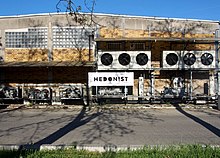A cool store or cold store is a large refrigerated room or building designed for storage of goods in an environment below the outdoor temperature. Products needing refrigeration include fruit, vegetables, seafood and meat. Cold stores are often located near shipping ports used for import/export of produce. Cool stores have been an essential part of the shipping industry since the late 19th century. Christian Salvesen expanded from a small Scottish whaling company when they established a cold store in Grimsby, then a major fishing port.[1] Nine Elms Cold Store, constructed in 1965, could hold 16,000 tons of meat, cheese and butter. It closed in 1979 and was used by squatters and various illegal activities before being demolished towards the end of the century.[2]

The stores themselves vary in size. A thirty hectares (74 acres) cold store with 200,000 tonne capacity was planned for Wuhan, China. [3]
Warehouse
editA cool warehouse or cold storage warehouse is a warehouse where perishable goods are stored and refrigerated. Products stored can be, amongst other things, food, especially meat, other agricultural products, pharmaceutical drugs, other chemicals and blood.[4][5]
See also
editReferences
edit- ^ "Obituary - Sir Gerald Elliot, former chairman of Christian Salvesen and patron of the arts in Scotland". Herald Scotland. 8 February 2018. Retrieved 11 February 2018.
- ^ Hill, Andy (31 October 2016). "16 creepy London stories to get you in the mood for Halloween". Time Out. Retrieved 11 February 2018.
- ^ Fruitnet (2008-10-31). "China's biggest cool store planned for Wuhan | Fruitnet". The Global Fresh Produce Portal. Retrieved 2010-01-02.[permanent dead link]
- ^ "New Jersey: Foodstuffs. Cold Storage. Regulation of. (Ch. 101, Act Mar. 16, 1916)". Public Health Reports. 31 (31): 2122–2124. 1916. JSTOR 4573937.
- ^ Holmes, George K. (1913). "Prevention of Waste and Seasonal Price Fluctuations Through Refrigeration". The Annals of the American Academy of Political and Social Science. 50: 48–56. doi:10.1177/000271621305000107. JSTOR 1012671. S2CID 153749376.